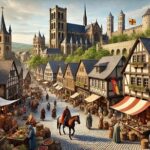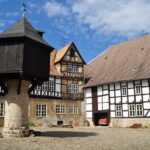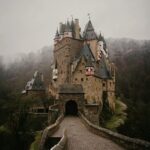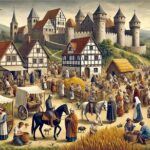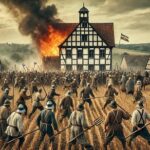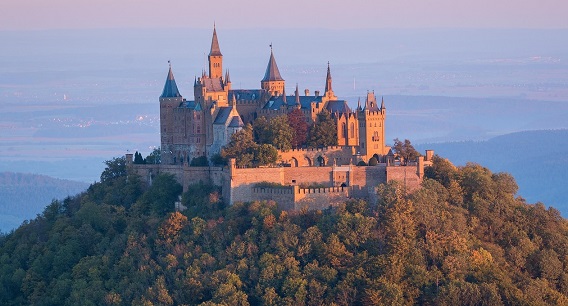
Towering spires. Crenellated walls. Hidden passageways and towering gates. Whether perched atop rocky cliffs or nestled in dense forest, German castles have long captured the imagination of visitors and historians alike. But these aren’t just romantic ruins—they’re powerful symbols of the medieval past.
In medieval Germany, architecture was more than art—it was military strategy, political messaging, and spiritual devotion, all carved in stone. From Romanesque fortresses to Gothic cathedrals, Germany’s architectural legacy tells the story of an empire in flux, its feudal lords, and its unshakable faith.
Let’s take a tour through the castles and construction styles that shaped medieval Germany—and still define its cultural landscape today.
The Rise of Castles in Germany
The earliest true castles in Germany appeared around the 9th and 10th centuries, during the era of Charlemagne and his successors. As local rulers gained autonomy under the Ottonian and Salian dynasties, they needed to protect their domains—and assert their status.
Thus, the castle (Burg) was born.
Early castles were made from wood and earth, but by the 11th century, stone construction became the norm. These fortifications weren’t just military—they were seats of power, courts of law, and symbols of noble prestige.
Types of German Castles
German castles came in many forms, depending on geography, purpose, and period:
- Höhenburgen (hill castles): Built on heights for defense and visibility, like Burg Eltz.
- Wasserburgen (water castles): Surrounded by moats, like Schloss Ahrensburg.
- Stadtburgen (city castles): Integrated into urban defenses, such as in Nuremberg.
- Motte-and-bailey castles: Early Norman-style with a central mound and wooden tower.
Later, castles grew more elaborate, with keeps, curtain walls, towers, drawbridges, and even chapels and libraries.
Life Inside a Castle
Medieval German castles weren’t just fortresses—they were homes:
- Great halls hosted feasts, ceremonies, and court sessions.
- Chambers housed the lord’s family and guests.
- Kitchens, storerooms, and stables supported daily life.
- Chapels provided space for worship.
They were cold, smoky, and dimly lit—but also places of art, music, and diplomacy. Tapestries and frescoes added color to the stone walls, and minstrels entertained during winter nights.
Architectural Styles: Romanesque and Gothic
Romanesque (10th–12th century)
- Thick stone walls
- Small, rounded windows
- Rounded arches
- Barrel-vaulted ceilings
Examples: Speyer Cathedral, Quedlinburg Abbey, early castle towers
This style reflected strength and order, perfect for a feudal society that valued security and authority.
Gothic (13th–15th century)
- Pointed arches
- Ribbed vaults
- Flying buttresses
- Large stained-glass windows
Examples: Cologne Cathedral, Freiburg Minster, late medieval palaces
Gothic architecture reached toward heaven—literally and spiritually. It embodied grace, complexity, and divine light, mirroring the cultural flowering of the High Middle Ages.
Religious Architecture
While castles defended the realm, churches and cathedrals uplifted the spirit. Every town had at least one church; major cities boasted multiple grand houses of worship.
- Monasteries like Maulbronn served as centers of education, charity, and spiritual reform.
- Cathedrals were built over centuries, combining Romanesque roots with Gothic glory.
- Many churches used local stone and regional variations of style.
The grandeur of these structures reflected the Church’s power—and the skill of German masons, who exported their techniques across Europe.
Castles in Warfare and Politics
German castles played key roles in medieval conflict:
- Bases during feudal feuds and dynastic wars
- Safe havens during invasions (like the Hungarian raids)
- Fortresses in the Investiture Controversy and Peasant Wars
They also acted as symbols of control. A noble might build a castle to guard a river crossing or intimidate rival families. Location was everything.
Some famous strongholds include:
- Burg Hohenzollern – ancestral home of the Prussian kings
- Marksburg – never destroyed, overlooking the Rhine
- Wartburg Castle – where Martin Luther translated the New Testament
Castles and Courts of the Holy Roman Empire
The Holy Roman Emperors often held court in Imperial Palaces (Kaiserpfalzen), such as in Goslar or Ingelheim. These weren’t fortresses so much as grand residences and government centers.
Imperial architecture blended Romanesque solidity with imperial symbolism—eagles, arches, frescoes depicting royal authority.
Decline and Romantic Revival
By the 16th century, gunpowder and cannons made traditional castles militarily obsolete. Many were abandoned or converted into manor houses.
During the 19th-century Romantic movement, castles were rediscovered and restored—sometimes reinvented entirely. Think:
- Neuschwanstein Castle – built by King Ludwig II as a romantic fantasy
- Hohenschwangau – rebuilt in pseudo-Gothic style
These fairy-tale structures inspired not just art, but even Disney’s castles.
Architectural Legacy Today
Germany boasts over 25,000 castles, ruins, and palaces—the highest concentration in Europe. They continue to:
- Attract millions of tourists
- Serve as museums and cultural centers
- Inspire filmmakers, writers, and architects
Cities like Heidelberg, Rothenburg ob der Tauber, and Bamberg still reflect their medieval layouts and architecture.
German castles and medieval architecture tell stories carved in stone—of war and worship, nobility and craftsmanship, faith and fantasy. From the rugged keeps of the Rhine to the soaring cathedrals of Cologne, they offer a window into the past—and a legacy that still shapes the soul of Germany.
Curious to explore more? Visit Medieval German Feudal Society, The Holy Roman Empire, or browse The Real Story Behind Bavaria’s Mad King Ludwig II.

